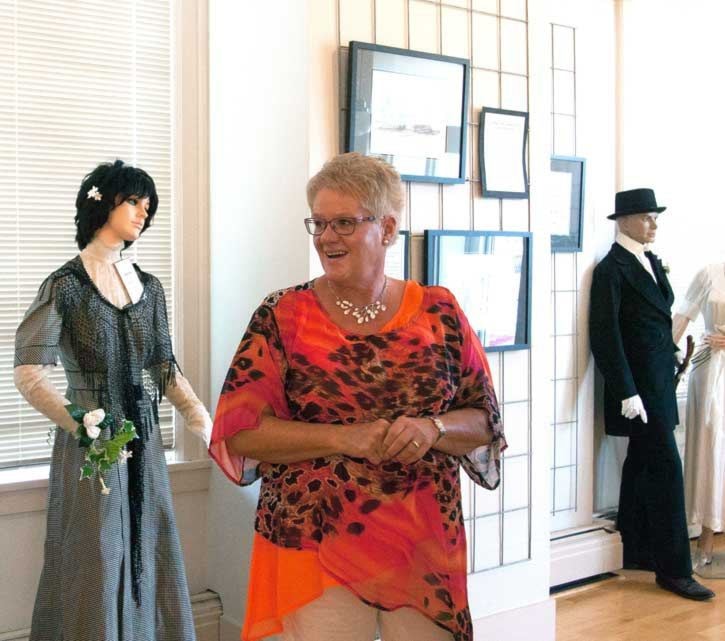As people drive between Castor and Stettler on Highway 12, there's an old barn at the side of the highway, its roof fallen in the centre, its walls leaning inwards.
Most people don't give the building a second glance, as falling-down buildings on the prairies aren't an uncommon sight. But for Donalda artist Linda Osetsky-Kneeland, the sight of the building is enough to stir her blood.
“Every time I see an old home or an old barn, I wonder – who lived there? Did they have children? What was their life like? Were they happy?”
It's prairie homesteads – in disrepair, falling apart and ravaged by time and weather – that makes up the bulk of Osetsky-Kneeland's art exhibit, which had its grand opening on Friday, June 26 in Donalda.
The art exhibit, Vanishing Heritage – A study in black and white, will be on until the end of July at the Donalda Art Gallery.
Osetsky-Kneeland, who said she can't remember a time when she didn't draw, said that while she always painted and drew, it wasn't until after her children were grown that she devoted a significant amount of her attention to the artistic endeavour.
Completely self-taught – she's never taken a class – Osetsky-Kneeland worked primarily in oil paints, with her work visible as murals at the Stettler pool and at the Donalda, Coronation and Brownfield schools, until she travelled to Australia several years ago.
She spent a year in the outback before returning to Canada, and two-or-three years later returned to Australia for nearly another whole year.
“I didn't know where to buy paints, and (when I could find them) they were expensive,” Osetsky-Kneeland recalled about her time in Australia. “So I got some pencils and went back to basics.”
That back to basics reignited her passion for working with pencils, the simplicity of carrying a sketchbook and pencils suitable for the Australian terrain which she was exploring.
“They have their old homesteads,” she said. “With corrugated iron roofs.” She said the metal roofs, as wind whistled through them, could make the highest-pitched sounds.
Before she left for Australia the second time, her grandson – at the time four-years-old – asked her about her sketchbook. When she explained what it was for, the young boy asked her to “draw everything she saw.”
So Osetsky-Kneeland drew and drew and drew, and when she returned to Canada, the first thing out of her grandson's mouth was, “Do you have that book?”
When she returned to Canada, though, Osetsky-Kneeland said she started to see the various homesteads around her and realized Canada's prairies had its own interesting pasts, just like Australia's outback did – and that as time went on, time was taking their toll on them.
So she decided to draw them and capture their stories before they were forgotten.
Osetsky-Kneeland heads out to the site she wishes to draw and spends time photographing the old house, barn, bridge of old wagon, capturing the lighting in a photograph. Once she has the photo that speaks to her artistic soul, she heads back home to begin sketching.
She sketches the picture twice before making a final copy, ensuring that she “has it right” before making the final work.
“I don't want there to be erasure marks,” she explained.
Then the drawings went into a box, carefully packed away, unless they were specifically drawn for someone she knew.
When in Australia, “all of the postcards I sent” were homemade ones of her drawings, Osetsky-Kneeland explained.
With the encouragement of her husband inspiring her, Osetsky-Kneeland decided to do the research on the various buildings and wagons she drew, and put together 32 different drawings, most drawn since December 2014, though six are from before that.
Time is an issue for Osetsky-Kneeland's preferred subjects. A week after taking photos of one building, the back wall of one building collapsed. Another time, a wind storm came in just days after she took her photos and blew a building down.
Others have stood the test of time, so sturdily built they're in some sort of use today – like an old house, which had so sturdily built a floor that today it is used to store fertilizer.
Osetsky-Kneeland used a range of 2H to 2B pencils for her work, though will sometimes use slightly darker pencils – usually, though, she'll just darken the lines by adding to them, as the softer pencils are too messy. It's why she never goes all the way to using charcoal, for example.
Each picture takes about 10 hours to draw, from going out to take the photos, test sketches and final product. And sometimes, it's going out to take the photos that is the best part.
“You go and look at the building,” she said. “That can be the neatest.”
